Cultivating Carnivorous Plants (2015)
SARRACENIA
Sarracenia ‘Gothic Rose’
156

NATCH GREYES
The North-American Pitcher Plant,
Sarracenia, has inspired movie-makers, florists,
and the everyday gardener since it was first
illustrated in 1576 by Matthias de l’Obel. Since
1731, when the genus was first described by
Joseph Pitton de Tournefort, Sarracenia has
been the subject of intense taxonomic study.
(Even William Bartram wrote about the genus
in his travels around the southeastern United
States)!
Traditionally, Sarracenia has been divided
into eight species: alata, flava, leucophylla, minor,
oreophila, psittacina, purpurea, and rubra. More
recent taxonomic work has divided the genus
in up to eleven species. Recent genetic
analysis has revealed that at least nine species
exist: alabamensis, alata, flava, leucophylla, minor,
oreophila, psittacina, purpurea, and rubra.
Interestingly, that genetic analysis also
revealed that convergent evolution has
probably played a large part in Sarracenia
evolution. For instance, Sarracenia flava and
Sarracenia oreophila, which are frequently said to
look remarkably similar, were revealed to be
very distantly related. Similarly, Sarracenia
alabamensis, which had previously been
identified as a subspecies of Sarracenia rubra,
was revealed to be more distantly related to
members of the Sarracenia rubra complex than
species such as Sarracenia leucophylla, which
looks markedly different. Yet, curiously, Sarracenia purpurea ssp. purpurea in flower. The distinctive
Sarracenia rubra ssp. jonesii, which was long
umbrella-like flowers of the species in the genus Sarracenia
thought to be as distantly related to the rest of
come in two colors - red or yellow - except for Sarracenia
the Sarracenia rubra complex as Sarracenia
purpurea ssp. burkii, which has light pink flowers.
alabamensis was revealed to be very closely
related.
Interestingly, that genetic analysis also revealed that Sarracenia alata is very closely related to Sarracenia
rubra complex. In fact, there is some suggestion that Sarracenia alata is merely a subspecies of Sarracenia rubra.
Additionally, the genetic analysis concluded that the plant often known either as Saracenia rosea or Sarracenia
purpurea ssp. venosa var. burkii was more closely related to Sarracenia purpurea ssp. purpurea and Sarracenia purpurea
ssp. venosa than the plant often known as Sarracenia purpurea ssp. venosa var. montana. (Taxonomically, each of the
four members of Sarrcenia purpurea should probably be a subspecies, and will be treated as such in this work).
It remains to be seen whether these nine species will be further divided or combined in light of future
genetic and taxonomic analysis. Part of the difficulty in determining how many species exist is due to the fact
that most species have overlapping ranges and flower at nearly the same time, resulting in a plethora of
157




CULTIVATING CARNIVOROUS PLANTS
hybrids, all of which are fertile, and many of
which interbreed with parent species. As a
consequence, many populations of otherwise
“pure” plants contain plants with hybrid
traits, making differentiation difficult.
Regardless of how many species of
Sarracenia actually exist, all species consist of
rosettes of hollow pitchers growing from a
central rhizome. In many species, growth is
progressive and directional. In other words,
as new pitchers grow, the rhizome elongates
horizontally along the soil surface. Over the
course of a growing season, such growth can
and often results in the growing point
splitting to create two or more growing
points emanating from a single rhizome. In
nature, the gradual, clump-forming nature of
Prey insects inside a Sarracenia x catesbaei pitcher.
Sarracenia can result in a single clone
populating large areas of a savanna.
Sadly, as with many plants native to the eastern seaboard of North America, Sarracenia have seen a rapid
and sustained habitat loss over the last few decades. Boggy savannas filled with towering pitchers stretching
towards the horizon are largely experiences of the past. Now, stories of savannas being ditched, bogs being
bulldozed, and plants being paved over abound. As a consequence, the true differentiation of Sarracenia
species may come too late for effective conservation of populations of each species in the wild.
Among the carnivorous plants, Sarracenia command a great deal of passion from growers, many of
whom find Sarracenia exceedingly easy to cultivate. Most species require a cool dormancy period, although
more southern species, such as Sarracenia minor, will tolerate a shorter dormancy than more northern species,
such as Sarracenia purpurea ssp. purpurea. Full sunlight and fairly large growing spaces are preferable for most
species, but not required as most growers find that dividing large plants promotes optimal growth.
In Cultivation
Most Sarracenia live in nutrient-poor environments with acidic soil and a
high water table. In the wild, some plants, such as Sarracenia purpurea ssp.
purpurea, prefer to grow in bogs, often in masses of living sphagnum moss.
Others, such as Sarracenia psittacina, prefer to grow in low-lying ditches and by
lakesides, which are frequently flooded. Still others, such as Sarracenia flava,
often grow in wet savannas, while others, such as Sarracenia minor can be found
in wet pine woods or on floating hummocks in the middle of a swamp.
Fortunately, in cultivation, Sarracenia do not require such diverse ecosystems.
Instead, all grow well in a mix of one part sphagnum peat to one part sand or
perlite and bottom watered via a tray which is always filled with some water.
Sarracenia are well-adapted to growing in full sun. Most experience
incredibly intense light in the wild, something which is difficult to replicate
with grow lights. For most growers, the easiest way to keep Sarracenia is to
place them outside in full sun during warm summer months. This allows the
Sarracenia purpurea
158
NATCH GREYES
plants to capture their own prey. Placing one-to-two Osmocote-style slow release fertilizer pellets near the
roots of an adult plant can significantly increase growth. In media that is too nutrient-rich, most Sarracenia will
produce non-carnivorous phyllodia, i.e. flattened leaves, in place of pitchers.
My standard growing guide for Sarracenia follows:
✵
Media: The most common mixture is one part sphagnum peat to one part sand. I’ve found that
substituting perlite for sand can result in better growth (and lighter pots!), but I’m not sure if that
would hold true for every grower.
✵
Moisture: Water via the tray method. Always keep water in the tray during the spring, summer, and
fall growing season. During winter dormancy, allow the tray to dry out and the media remain just
moist in order to prevent rot.
✵
Humidity: Humidity is not a big concern for Sarracenia, but they do need some humidity. Growers in
dry regions should consider keeping the plants in a humid greenhouse or in a terrarium indoors.
✵
Pot Size: Sarracenia have long roots. I would recommend one gallon pots for any plants older than
two years.
✵
Feeding: Fertilizing Sarracenia can be done--but must be done carefully. It is much easier to keep the
plants outside during the growing season and let them catch their own prey. If this is not an option,
consider filling the pitchers with a little orchid fertilizer or placing one or two osmocote-style
fertilizer pellets near the roots of an adult plant. Foliar feeding via spraying the pitchers has no
noticeable effect if the fertilizer is not put into the pitchers.
✵
Temperature: During the growing season, Sarracenia should not be exposed to freezing temperatures,
as that will kill new, unopened pitchers. The plants will tolerate daytime highs up to 95° F (35° C).
✵
Dormancy: A cold winter dormancy is necessary for long-term success. During winter dormancy,
temperatures should not exceed 50° F (10° C), if possible, and light should be reduced.
✵
Propagation: Sarracenia can be propagated through seed, leaf-pullings, division, or rhizome cuttings.
o
Seed: The slowest way to propagate Sarracenia is through seed. As with most carnivores, seed
should be stored in the refrigerator when not being germinated. In refrigerated storage, seed
can remain viable for several years. Seed must be exposed to a month-long cold stratification
process in order to germinate successfully. The easiest way to do this is to place the seed on
top of a suitable, damp medium, cover this with plastic wrap, and place in the refrigerator
for a month. Seed should germinate within three to four weeks after such treatment, if
viable.
o
Leaf-pullings: Leaf-pullings are the most difficult way to produce new plants. Essentially, a
leaf should be pulled from the rhizome with as much of the rhizome attached as possible.
The rhizome portion should then be buried in a suitable medium, the pitcher cut down, and
the whole thing placed in a clear plastic bag and placed out of direct sun. If successful, a new
plant will sprout from the base.
o
Division: The easiest way to propagate Sarracenia is division. This is best done during
dormancy, shortly before spring growth begins. Divide the crown in as many pieces as there
are growth points, while trying to keep as much of the root system intact as possible. Pot up
the new plants.
o
Rhizome Cuttings: Perhaps the riskiest way of propagating Sarracenia is via rhizome cuttings.
An inch long (2.5 cm) section of healthy rhizome ( i.e. rhizome that is white, not brown) may
be removed from a growing plant. This should be laid horizontally on top of a suitable
medium. The rhizome should then be covered with a little media. Growth should appear in a
few weeks. Please note, however, that dividing the rhizome will deprive the parent plant of a
store of nutrients, and, without a growth point, the new rhizome cutting is much more
susceptible to rot than plants with a growth point.
159




CULTIVATING CARNIVOROUS PLANTS
Sarracenia alabamensis
Although only distantly related to Sarracenia rubra, Sarracenia
alabamensis is often confused for Sarracenia rubra, specifically
Sarracenia rubra ssp. wherryi. It is easy to see why. Both commonly
have yellow pitchers with faint fenestrations near the top of the
pitcher and are nearly identical in pitcher shape. The only real
taxonomic differences are that Sarracenia alabamensis has 20 inch (50
cm) tall pitchers compared to Sarracenia rubra ssp. wherryi’s 16 inch
(40 cm) tall pitchers, and Sarracenia alabamensis is bright yellow in the
upper third of the pitcher, whereas Sarracenia rubra ssp. wherryi is not
as bright yellow.
Native to Elmore, Autauga, and Chilton counties in Alabama,
Sarracenia alabamensis is geographically separated from the members
of the Sarracenia rubra Complex. Yet, like Sarracenia rubra ssp. jonesii is
federally endangered due to its limited distribution and low rate of
incidence. Its geographic separation from the Sarracenia rubra
complex would indicate that it is possible Sarracenia alabamensis
evolved from the Sarracenia rubra Complex, but, given that recent
genetic analysis has indicated that Sarracenia leucophylla is more
closely related to Sarracenia rubra than Sarracenia alabamensis is to
Sarracenia rubra, it is likely that the similarities between Sarracenia
alabamensis and Sarracenia rubra ssp. wherryi are entirely due to
convergent evolution. In other words, the similar features of
Sarracenia alabamensis and Sarrracenia rubra ssp. wherryi evolved
independently, probably due to selection pressures that encouraged
that pitcher shape and coloration.
Due to the small numbers of Sarracenia alabamaensis in existence
and the ongoing controversy surrounding its elevation to species
status, it is not too surprising that no varieties have been formally
identified, yet. It is likely, however, that at least only variant will be
described. That variant differs from the typical plants by having
pitchers which are entirely red on the external surface of the
pitcher. If taxonomic convention holds, this variant will be
identified as Sarracenia alabamensis var. rubricorpora while the typical
variant with yellow pitchers will be identified as Sarracenia alabamensis
var. alabamensis.
In cultivation, Sarracenia alabamensis is an easy species. It is,
however, poorly adapted to colder climates, and its hybrids are
often indistinguishable from hybrids with members of the Sarracenia
Sarracenia alabamensis in cultivation.
rubra Complex. Infrequently, it can be found to have hybridized in
This variant has rather brilliant
the wild with Sarracenia alata. These hybrids are known as Sarracenia
coloration on its pitchers.
x ahlessi.
160

NATCH GREYES
Sarracenia alata
Sarracenia alata is closely related to Sarracenia rubra, so much
so that it is sometimes difficult to distinguish the two species in
cultivation. In the wild, Sarracenia alata and Sarracenia rubra are
readily distinguished as their ranges overlap only in a small
portion of Alabama, north of Mobile. In total, Sarracenia alata has
two geographically separate ranges. The eastern range extends
from the eastern Louisiana border to the middle of Alabama,
encompassing, mostly, southern Mississippi. The western range
extends from Big Thicket in Texas to just east of the western
Louisiana border, encompassing about the middle third of
Louisiana. Plants from both ranges have yellow flowers.
In its eastern range, Sarracenia alata grows in pine savannas
and seepage bogs. The soil is often sandy clay. In its western
range, Sarracenia alata grows, mostly, in oak savannas. In Big
Thicket and the surrounding area, however, Sarracenia alata grows
in pine savannas.
Recently, Sarracenia alata has been divided into the following
varieties, based almost entirely on the coloration of the pitchers:
✵
var. alata - Yellow-green pitchers with slight red veining,
and, sometimes, hair on the outside of the pitchers. The
hairy versions are sometimes known as f. pubescens. This
variety is found in both ranges, however, west of the
Mississippi, this variety will often have a throat bulge,
which is not present in plants from east of the
Mississippi.
✵
var. atrorubra - Bright red pitchers which turn dark, A dark form of Sarracenia alata, probably
almost black as the pitchers age. This variety is found
Sarracenia alata var. rubrioperculata.
only in the eastern range.
✵
var. cuprea - Yellow-green pitchers with a copper-top, like Sarracenia flava var. cuprea. This variety is
found only in the eastern range.
✵
var. nigropurpurea - Dark-purple-to-almost-black pitchers that turn darker as the pitchers age. This
variety only grows in the eastern range.
✵
var. ornata - As with other species var. ornata, these pitchers are heavily veined. This variety only grows
in the eastern range.
✵
var. rubrioperculata - Yellow-green pitchers with dark purple, almost black coloration on the inner lid
and upper “mouth” of the pitcher. This variety only grows in the eastern range.
In cultivation, some growers have reported that Sarracenia alata var. atrorubra and Sarracenia alata var.
nigropurpurea can be confused, as their only distinguishing features are the darkness of color of the pitchers.
Furthermore, some unconfirmed reports have indicated that seedling offspring of Sarracenia alata var.
nigropurpurea can be lighter in color, replicating Sarracenia alata var. atrorubra. Therefore, I think more is needed
to distinguish these two varieties.
161



CULTIVATING CARNIVOROUS PLANTS
Sarracenia flava
Sarracenia flava var. ornata
The Yellow Pitcher Plant, Sarracenia flava, is a three to four foot (up to 120 centimeter) tall, columnar
pitcher that is often bright yellow in color with red patch on the pitcher column and is native to the
southeastern coastal plain, a swath of land stretching from eastern Alabama to southern Virginia. The flowers
are yellow. With such a large range, it is not surprising that this species, which favors savannas, has a number
of different color variations, which have been subdivided by botanists as follows:
✵
var. atropurpurea - Entirely red pitchers. Native to the Atlantic coast.
✵
var. cuprea - Yellow pitchers with a red blotch on the pitcher column and a copper
colored lid. Native to the Atlantic coast.
✵
var. flava - Yellow pitchers with a red blotch on the pitcher column. Veins radiate
upwards and downwards from the blotch.
✵
var. maxima - Green pitchers, but not anthocyanin free.
✵
var. ornata - Yellow pitchers with heavy red veining throughout the pitcher.
✵
var. rubricorpora - The entire exterior of the pitcher is red, but the inner lid and
inner tube are yellow. A red blotch is present on the pitcher column.
✵
var. rugelii - Yellow-pitchers with a red blotch on the pitcher column. No veins are
present.
Sarracenia flava is one of the largest and most common Sarracenia in cultivation. More
often than not, new growers obtain Sarracenia flava var. rugelii plants as their first Sarracenia
flava. Sarracenia flava var. ornata is also a popular variety of Sarracenia flava. Hybrids with
most varieties of Sarracenia flava typically exhibit a red blotch on the pitcher column,
Sarracenia flava
partway between the lid and mouth.
var. rugelii
162






NATCH GREYES
Sarracenia leucophylla
A field of Sarracenia leucophylla. Sights like this were once common along the Gulf Coast.
The White Topped Pitcher Plant, Sarracenia leucophylla, is
a showy, Gulf Coast native known in the floral industry for
producing expensive, desirable pitchers. In the wild, it is
commonly found en masse in a peat-sand mixture. The red
flowers stand in strong contrast to the white pitchers left
over from last year’s growth. The species is so distinctive,
that it is easy to identify pure Sarracenia leucophylla or hybrids
with Sarracenia leucophylla.
Although several authors have attempted to identify
different varieties of Sarracenia leucophylla, the truth is that the
range of Sarracenia leucophylla is overlapped by a host of other
species, it flowers at a time that allows for overlap with other
species, and it often grows with other species, meaning very
few stands hold pure Sarracenia leucophylla. As a consequence,
it is virtually meaningless to designate varieties based on
color of venation or blushes of red or other colors on the
white, upper portions of the pitchers.
The one variety of Sarracenia leucophylla which seems
consistent, besides the anthocyanin-free variant is Sarracenia
leucophylla var. alba, which has a washed out, white top. No
veins are present. In addition to Sarracenia leucophylla var. alba,
Sarracenia leucophylla is currently unique in having one
cultivar, ‘Tarnok’, which produces double flowers.
Regarding hybrids, hybrids with Sarracenia leucophylla
Sarracenia leucophylla, possibly with
almost always have a ruffled lid and, often, white areoles.
Sarracenia rubra in its ancestory.
163



CULTIVATING CARNIVOROUS PLANTS
Sarracenia minor
Sarracenia minor in northeast Florida.
The Hooded Pitcher Plant, Sarracenia minor, is one of the easiest to
distinguish and least controversial of the Sarracenia. All forms have (mostly)
green pitchers with hoods that curve up, over the back of the pitcher and past
the mouth of the pitcher. The back of the hood and pitcher are covered with
prominent white areoles. The flowers are yellow. Its distribution stretches
from the Apalachicola National Forest to the Atlantic Ocean, and from
Orlando, Florida, to Wilmington, North Carolina. It is the most southern
Sarracenia, and, unsurprisingly, the least cold tolerant of all the species.
Sarracenia minor is traditionally divided into two varieties - var. minor and
var. okeefenokeensis. The division is entirely based on size. Sarracenia minor var.
minor is the smaller and shorter variety. Recently, an additional type - f.
viridescens - has been formally described. Sarracenia minor f. viridescens is, as with
all species of Sarracenia, the all-green ( i.e. anthocyanin free) form of the
species.
Donald Schnell has made some effort to distinguish Sarracenia minor var.
okeefenokeensis from Sarracenia minor var. minor, noting in his 2002 Carnivorous
Plants of the United States and Canada that, even juvenile plants, from the Ware
Sarracenia minor and
County, Georgia/Okefenokee Swamp area are “just different,” producing Drosera intermedia growing
slimmer pitchers (as one might expect for taller plants) and commonly
in Okeefenokee Swamp.
164








NATCH GREYES
Sarracenia minor with gradient coloration.
producing spring phyllodia. Having explored the Okefenokee Swamp and the area to its southeast extensively,
I remain unconvinced that the plants of Ware County are a separate variety. In my experience, the size of
Sarracenia minor plants was highly dependent upon microclimatic conditions, although plants from areas closer
to the Okefenokee Swamp were generally slightly larger, and some clones seemed more inclined to produce
phyllodia than others. For example, mature plants from near my home in St. Johns County, Florida, which
populated a drier pine wood on a golf course, would regularly produce pitchers about two feet (60 cm) tall.
Phyllodia were never present. In contrast, plants from another location half-a-mile away would produce
pitchers only a foot (30 cm) tall, and phyllodia would be produced in early summer.
As I mentioned in the Introduction, I regularly participated in plant rescues while living in Florida. As a
consequence, I grew Sarracenia minor sourced from at least a dozen homebuilding and business sites. In situ,
some plants would appear to have distinctive phenotypes. After growing those plants in near identical
cultivation conditions, i.e. a bog garden in my yard, nearly all of the plants reverted to looking like a typical
Sarracenia minor, although some did continue to produce phyllodia or grow larger than others. Therefore, I
am not yet convinced that enough fieldwork has been done on Sarracenia minor to merit a division of that
species into distinctive varieties. I believe more work needs to be done on Sarracenia minor, particularly those
growing in the swath of land southeast of the Okeefenokee Swamp before Sarracenia minor can be said to have
distinct varieties. Right now, there is simply too little fieldwork to substantiate a breakdown into varieties, and
recent genetic analysis has not revealed much, if any, genetic differentiation between plants identified as var.
minor and those identified as var. okeefenokeensis.
165
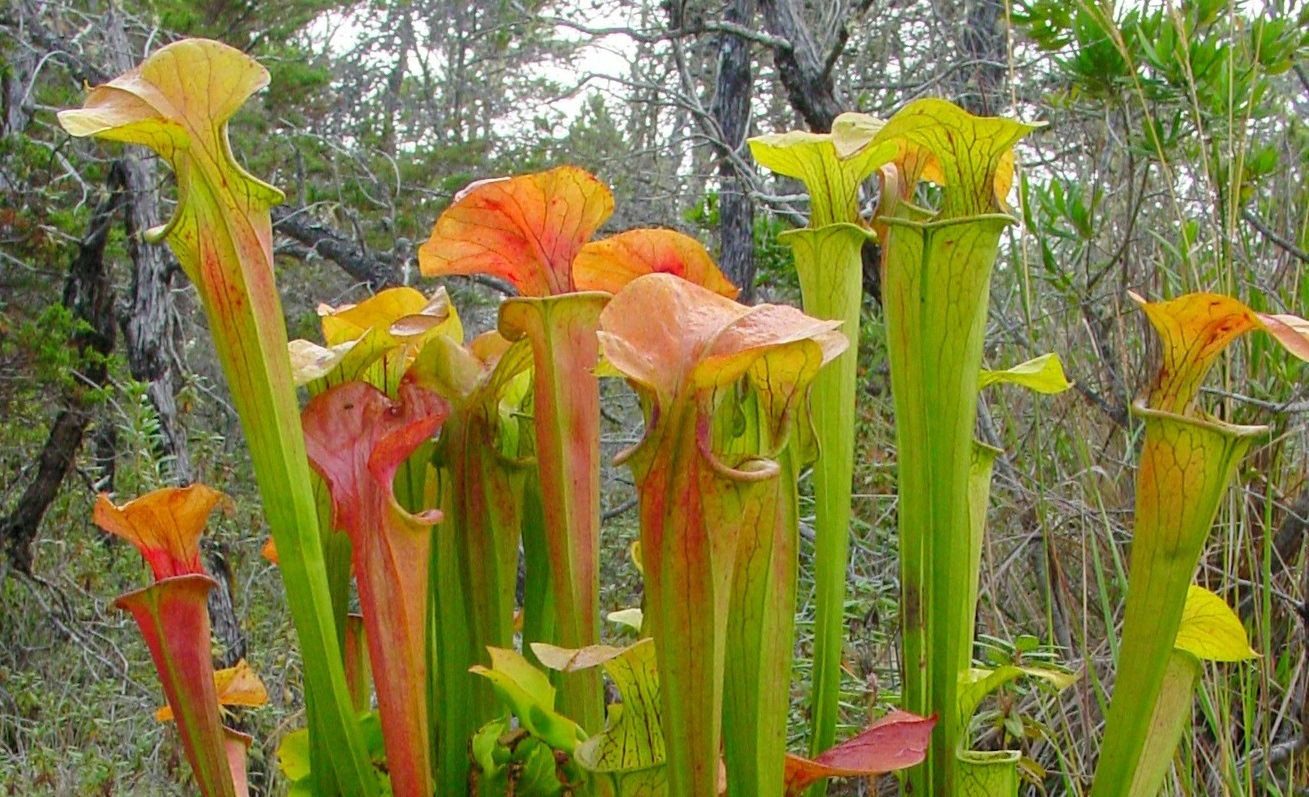

CULTIVATING CARNIVOROUS PLANTS
Sarracenia oreophila
Sarracenia oreophila is among
the rarest of Sarracenia, found
only in a few locations in
northeast Alabama. It has been
said to be easily confused with
Sarracenia flava, but historical
records show that botanists
have more often confused it
with
Sarracenia
rubra
than
Sarracenia flava. Much like
Sarracenia
flava,
Sarracenia
oreophila has yellow flowers.
Also
like
Sarracenia
flava,
Sarracenia
oreophila
produces
phyllodia in place of pitchers in
late summer as a consequence
of its native habitat seeing little
rainfall in late summer. These
phyllodia are unlike Sarracenia
flava’s phyllodia in that they are
strongly curved, not straight
and sword-shaped.
Among
the
southern
pitcher
plants,
Sarracenia
oreophila
sees
the
coldest
winters. In winter, Sarracenia
oreophila can see snow and cold
snaps to 0° F (-18° C). This
can, and sometimes does, result
in the clay-based, sandy soil of
the seepage bogs and streams
the species inhabits freezing
A particularily colorful Sarracenia oreophila.35
solid for several weeks.
There are two varieties of Sarracenia oreophila - var. oreophila and var. ornata. Sarracenia oreophila var. oreophila is the “typical” plant, green with light red veining on the pitcher. Sarracenia oreophila var. ornata is the more
heavily veined variety. The deep burgundy veins and “mouth” of Sarracenia oreophila var. ornata’s pitchers stand
in stark contrast to the rest of the pitcher, which is often suffused with a light, almost white, yellowish-green.
Unsurprisingly, growers find Sarracenia oreophila var. ornata more desirable than Sarracenia oreophila var. oreophila.
Although Sarracenia oreophila only grows one-to-two feet (30 - 60 cm) tall, hybrids with Sarracenia oreophila
as one of the parents often grow much taller than either parent. These also usually have prominent throat
bulges just below the pitcher lip. Hybrid offspring are also known for their cold-hardiness, a feature normally
reserved for hybrids with Sarracenia purpurea ssp. purpurea.
166
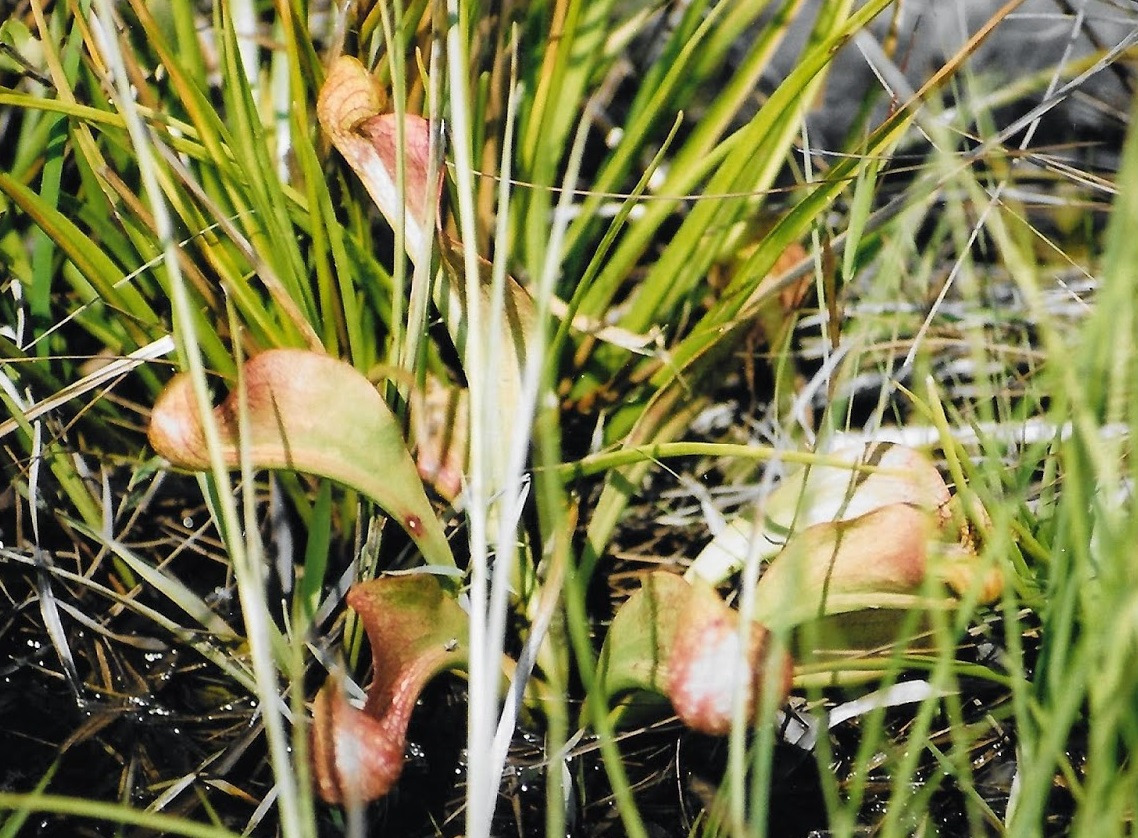

NATCH GREYES
Sarracenia psittacina
The aptly-named
Parrot Pitcher Plant,
Sarracenia psittacina, has
short pitchers shaped
like the head of a
parrot, which lay along
the ground. Its flowers
are red, except for the
“all green” anthocyanin
free variants. Sarracenia
psittacina prefers to grow
in areas that frequently
flood. This allows its
strange, Darlingtonia- like,
pitchers to “fish.” Most
of its prey consist of
mosquito
larva
and
other
small
aquatic
creatures, although the
occasional fish has been
spotted. Aquatic prey is
helped along its path by
hairs that point in the
Sarracenia psittacenia in the wild, growing very near a lakeshore. It is not
opposite direction of
uncommon to find this species almost overrun by native grasses in the lower
true
escape.
These
portions of roadside ditches.
misleading
hairs
prevent escape.
Sarracenia psittacina is native to the Gulf Coast from the border of
Louisiana to the Apalachicola National Forest in Florida. From the
Apalachicola National Forest, the species grows north and east, into
Georgia, where its range extends east to the Okefenokee Swamp.
As with Sarracenia minor, Sarracenia psittacina is claimed to have a
larger variant grow within the confines of the Okefenokee Swamp. This
larger variant has been named var. okeefenokeensis. (The ordinarily
Sarracenia psittacenia is var. psittacina). Both varieties have associated all-
green ( i.e. anthocyanin free variants) - f. viridescens (for var. psittacenia) and
f. luteoviridis (for var. okeefenokeensis). Ordinarily, Sarracenia psittacina
pitchers are six-to-eight inches (15 - 20 cm) long. The larger varieties can
see pitchers up to 12 inches (30 cm) long.
Hybrids with Sarracenia psittacina usually grow pitchers that are
angled at about 45 degrees from the ground. Often, they possess
elongated, closed hoods, giving them a characteristic “bulbous” shape.
The most common hybrid is Sarracenia x formosa, which is a hybrid with
Sarracenia psittacenia
Sarracenia minor.
167
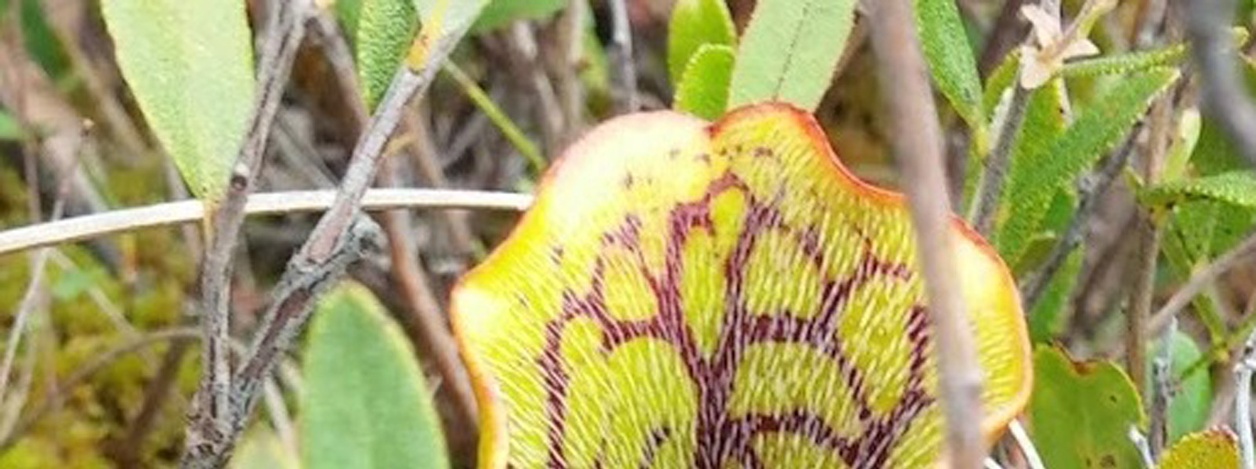


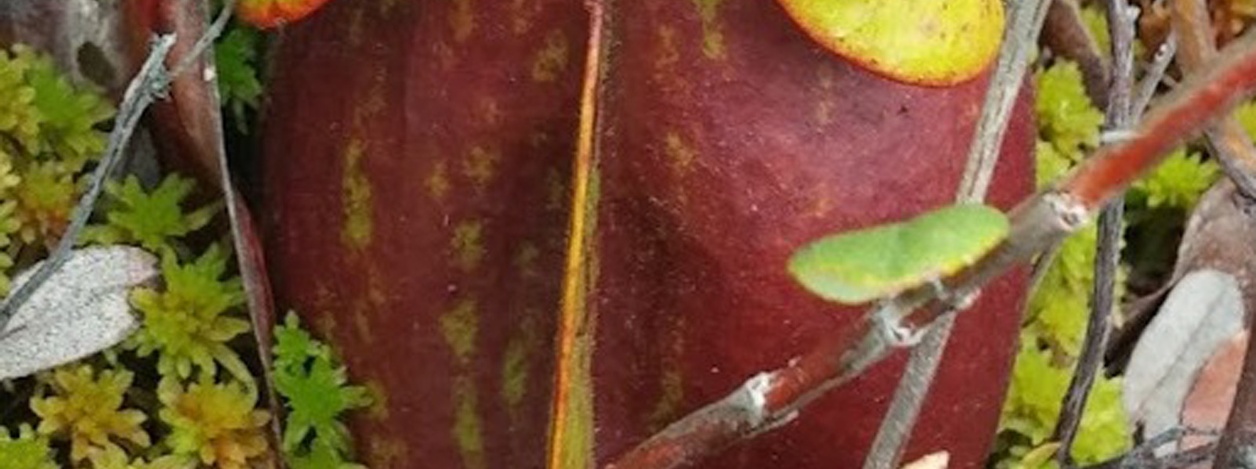
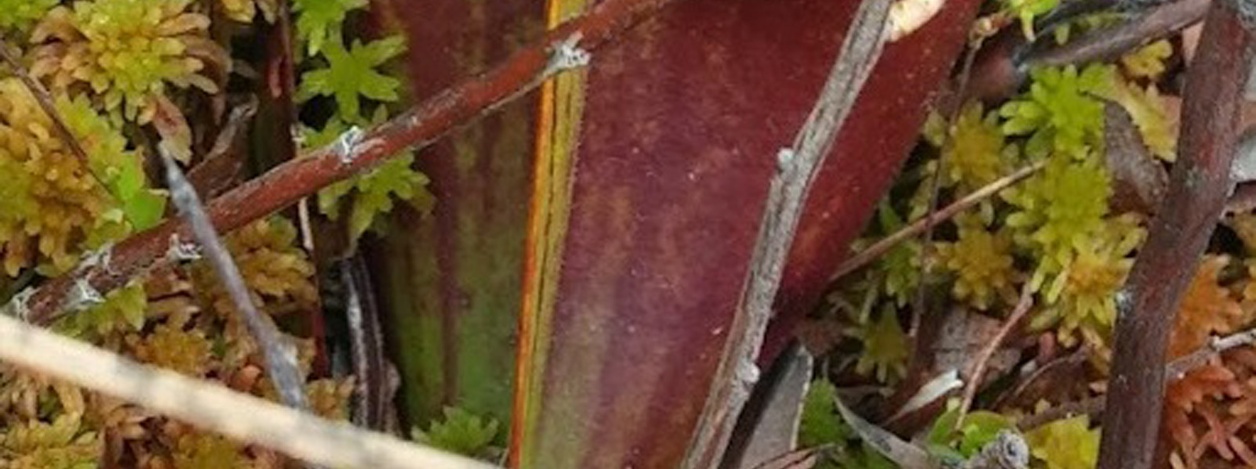
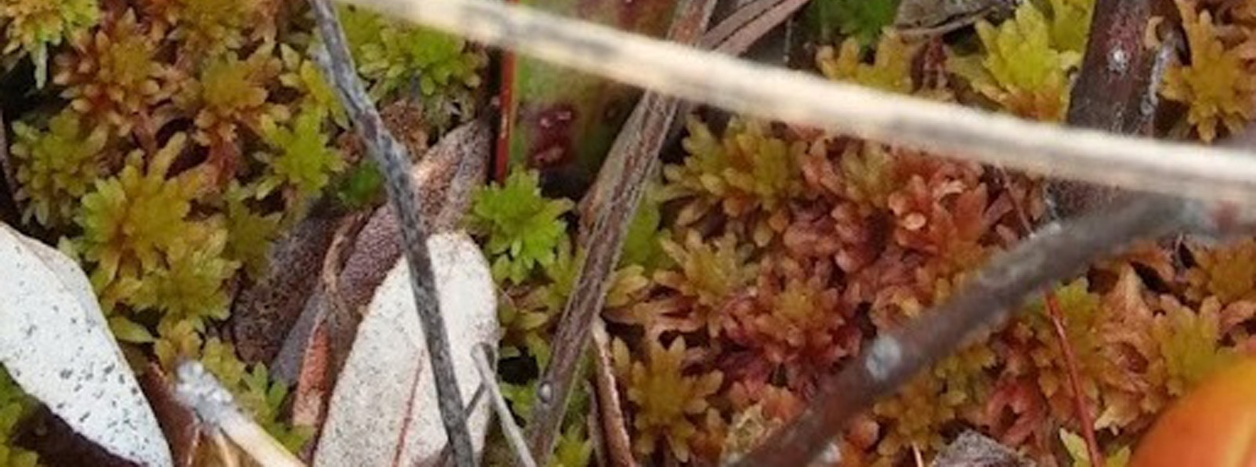
CULTIVATING CARNIVOROUS PLANTS
Sarracenia purpurea
More time has been spent attempting to determine the
correct division of Sarracenia purpurea into subspecies and
varieties than probably any other group of plants in the
genus Sarracenia. All members of the Sarracenia purpurea
Complex have short, decumbent pitchers, with the pitcher
opening curved upwards, to face the sky, and a hood which
does not cover the pitcher opening. Flowers are ordinarily
red, except for Sarracenia purpurea ssp. burkii, which produces
distinctive pink flowers. Research has found that no
members of this species produce digestive enzymes.
Historically, Sarracenia purpurea has been divided into
two subspecies - ssp. purpurea and ssp. venosa. Sarracenia
purpurea ssp. purpurea is the more northern of the two
subspecies. The difference between these two subspecies is
as follows:
1. The ratio of the length of the pitcher tube to
opening is 3:1 or greater in ssp. purpurea, but less
than 3:1 in ssp. venosa.
2. The outside of the pitcher is smooth and hairless
for ssp. purpurea, but has many short hairs for ssp.
venosa.
3. The flowers are dark red in ssp. purpurea, but bright
red in ssp. venosa.
4. If the pitcher hood is pinched together, it will not
extend past the edges of the pitcher mouth for ssp.
purpurea, but will for ssp. venosa.
In the wild, these two subspecies overlap, and
hybridize in the New Jersey Pine Barrens. In cultivation,
tissue cultured or commercially grown plants available at
retail stores are often hybrids between the two subspecies,
as hybrids often display a vigorous growth pattern and more
likely to keep good color throughout winter.
Traditionally, the other two members of Sarracenia
purpurea, identified as burkii and montana, have been relegated
to variety status within the subspecies venosa. Taxonomic
Sarracenia purpurea ssp. purpurea with an
analysis has also given rise to the identification of burkii as a
interesting color pattern. Field studies have
separate species, Sarracenia rosea. Recent genetic work has
shown signficant phenotypical variation
revealed, in fact, that these two members should be
between bogs for Sarracenia purpurea ssp.
identified as their own subspecies - Sarracenia purpurea ssp.
purpurea.
burkii and Sarracenia purpurea ssp. montana.
Sarraenia purpurea ssp. burkii is from the Gulf Coast region and is similar to Sarracenia purpurea ssp. venosa in
all respects except that it has a large, undulating hood and light pink flowers. Sarracenia purpurea ssp. montana is
from the Piedmont region of Georgia and North Carolina. It is genetically isolated from coastal populations
168




NATCH GREYES
Sarracenia purpurea ssp. burkii
and has a hood which curves inwards at the top,
resulting in the sides nearly touching, and has
shorter hairs, and bright red venation with wider,
coarser veins than Sarracenia purpurea ssp. venosa.
Genetic analysis reveals that this subspecies is
probably the most ancient of the Sarracenia purpurea
subspecies.
Hybrids with Sarracenia purpurea usually
produce semi-erect pitchers, with pitchers open to
the sky. The hoods are often ruffled and provide
no protection from the rain. Frequently, hybrids
with ordinary Sarracenia purpurea plants will produce
offspring with dark red coloration, sometimes
darker than the parent Sarracenia purpurea.
Oftentimes, the hybrid progeny of Sarracenia
purpurea are poor insect catchers, and the pitchers
are prone to collapse or overflow if subjected to
heavy rains. This is especially true of hybrids
created with tall species, such as Sarracenia flava or
Sarracenia leucophylla. Hybrids with Sarracenia purpurea
are some of the most sought-after hybrids in the
collector market. The cold hardiness alongside the
often unique shape of the pitchers is highly
desirable.
Sarracenia leucophylla x Saracenia purpurea ssp. burkii
169




CULTIVATING CARNIVOROUS PLANTS
Sarracenia rubra
The most complex Sarracenia species to
describe is Sarracenia rubra. Commonly known
as the “Sweet Pitcher Plant,” the only feature
that truly unites this species is its flower. All
subspecies of Sarracenia rubra have exactly the
same flower. These flowers are small, red, and
produce a sweet scent (hence its common
name). Unlike other species of Sarracenia,
members of the Sarracenia rubra Complex are
capable of producing two flowers per growing
point. (Most Sarracenia only produce one
flower per growing point).
The pitchers of the plants identified as
Sarracenia rubra vary considerably, leading many
authors to argue that there are a host of
different species with the same flower.
(Species are typically designated based on their
flower structure.) Geographically, the range of Sarracenia rubra ssp. gulfensis in the wild. This subspecies
Sarracenia rubra is fractured, with each different
can often be found growing in almost pure sand in
population having different looking pitchers.
permanently waterlogged areas.
I will follow the traditional subspecies divisions of the Sarracenia rubra Complex here -
✵
ssp. gulfensis - This native to Florida’s Gulf Coast and Taylor County, Georgia, has 24 inch (61
centimeter) tall pitchers, sometimes with a noticeable bulge in the pitcher throat, as with ssp. jonesii.
The pitchers are generally yellow, but can be red, and an anthocyanin-free variant is known.
✵
ssp. jonesii - This variety, from the Piedmont area of North and South Carolina has pitchers up to 24
inches (61 centimeters) tall, and is listed as federally endangered. (It is erroneously known as
Sarracenia jonesii). The pitchers are yellow and highly veined with a noticeable bulge in the pitcher
throat. There is an anthocyanin free variant of this variety.
✵
ssp. rubra - This eastern seaboard native has pitchers up to 18 inches (46 centimeters) tall, and an
average pitcher to mouth ratio of 20:1. The pitchers are yellow and highly veined. It is the most
common variety in cultivation.
✵
ssp. wherryi - This native to southwestern Alabama and eastern Mississippi is a shorter version of
Sarracenia alabamensis, only growing to 16 inches (40 centimeters) tall. It has even fainter fenestrations,
and is not bright yellow on the upper third of the pitcher.
In the wild, most members of the Sarracenia rubra Complex grow in exceptionally wet areas, compared to
other upright Sarracenia. (In one notable personal instance I found a stand near quicksand.) Like many of the
Sarracenia on the Gulf Coast, they prefer open grasslands over pine barrens (which are frequently inhabited by
Sarracenia minor and Sarracenia purpurea nearer the East Coast).
In cultivation, it is difficult to get members of the Sarracenia rubra Complex to achieve the large sizes seen
in the wild. In cultivation, most will only grow to about 18 inches (46 cm) tall.. Furthermore, in cultivation, it
has been noted that many subspecies appear less distinct from one another than they do in the wild. The
reason for this is probably due to different habits exerting different pressures on the plants than would be
seen in one, homogenous habitat.
170







NATCH GREYES